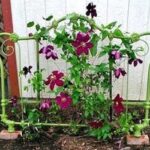Are you considering starting a vegetable garden in South Africa? Whether you’re new to gardening or an experienced green thumb, understanding the unique climate and conditions of South Africa is essential for success. In this article, we’ll explore the ins and outs of vegetable garden designs and layouts in South Africa, offering tips and advice to help you create a thriving garden of your own.
When it comes to vegetable garden designs and layouts in South Africa, there are a few key factors to consider. From choosing the right location and preparing the soil to selecting the best vegetables for the climate, each step plays a crucial role in the overall success of your garden. By understanding these elements and making informed decisions, you can create a beautiful and productive vegetable garden that thrives in the South African environment.
Throughout this article, we’ll delve into various aspects of vegetable gardening in South Africa, including soil preparation and fertilization, watering and irrigation systems, maintenance and pest control, traditional vs. modern designs, as well as incorporating indigenous plants into your garden. With our comprehensive guide, you’ll be equipped with the knowledge and know-how to create a successful vegetable garden that flourishes in the diverse landscapes of South Africa.
Choosing the Right Location for Your Vegetable Garden
When it comes to vegetable gardening in South Africa, choosing the right location for your garden is crucial for the success of your crops. Here are some important factors to consider when selecting the best spot for your vegetable garden:
- Sunlight: Vegetables typically require at least 6-8 hours of direct sunlight per day. Choose a location that receives ample sunlight throughout the day, especially during the growing season.
- Soil Drainage: Ensure that the location you choose has well-draining soil to prevent waterlogging, which can lead to root rot and other plant diseases.
- Accessibility to Water: It’s important to place your vegetable garden near a water source or have easy access to irrigation for regular watering needs.
In addition to these factors, consider the proximity of your vegetable garden to potential sources of contamination such as industrial sites, highways, and pollution sources. Avoid locations with potential chemical contamination.
Ultimately, the right location for your vegetable garden will greatly impact its success. Taking the time to carefully select an ideal spot will set the stage for a productive and abundant harvest.
Soil Preparation and Fertilization for Vegetable Gardens in South Africa
When it comes to setting up a successful vegetable garden in South Africa, soil preparation and fertilization are crucial steps. Without proper soil and the right nutrients, your vegetables may not thrive as they should. Here are some tips to help you prepare your soil and ensure that your vegetables get the nutrition they need:
1. Test Your Soil: Before planting anything, it’s important to test your soil to determine its pH levels and nutrient content. You can do this by purchasing a DIY soil testing kit or by sending a sample to a professional lab. Once you know what nutrients your soil lacks, you can make adjustments accordingly.
2. Improve Soil Structure: In many parts of South Africa, the soil can be sandy or clay-like, which can affect drainage and nutrient absorption. To improve soil structure, consider adding organic matter such as compost, manure, or peat moss. This will help loosen compacted soil and improve its ability to retain moisture.
3. Fertilize Wisely: Different vegetables have different nutritional needs at different stages of growth, so it’s important to choose the right fertilizer for each type of plant. Organic fertilizers like fish emulsion or seaweed extract are popular choices among South African gardeners because they provide slow-release nutrients without harmful chemical additives.
By taking the time to properly prepare your soil and provide adequate fertilization for your vegetable garden in South Africa, you will set yourself up for success and ensure a bountiful harvest of fresh, healthy produce. Remember that healthy soil leads to healthy plants.
Selecting the Best Vegetables for South African Climates
In South Africa, the climate varies from region to region, ranging from Mediterranean to subtropical and even desert-like in some areas. When it comes to vegetable gardening, it is crucial to select the best vegetables that are well-suited for the specific climatic conditions of your area. Understanding the climate and knowing which vegetables thrive in different regions will help ensure a successful harvest.
In the Mediterranean climate zones, which include the Western Cape and parts of the Eastern Cape, vegetables such as tomatoes, peppers, eggplants, and herbs like rosemary and thyme flourish due to the hot, dry summers and cool, wet winters. On the other hand, in the subtropical regions like KwaZulu-Natal and Mpumalanga, heat-loving vegetables such as sweet potatoes, okra, cucumbers, and tropical fruits like bananas and papayas do well in the warm and humid conditions.
For those living in arid or semi-arid areas like the Karoo or parts of the Northern Cape, drought-resistant vegetables are a better choice. These include spinach, Swiss chard, carrots, onions, and water-wise herbs like lavender and sage. Understanding which vegetables are best suited for your specific climate will greatly increase your chances of a productive vegetable garden.
When planning your South African vegetable garden based on climate, it’s also important to consider microclimates within your own garden. Observe which areas receive more sunlight or have better drainage than others. This will help you make informed decisions when selecting vegetables that will thrive in each specific location within your garden.
Overall, being mindful of South African climates and choosing vegetables accordingly can lead to a flourishing vegetable garden with bountiful harvests all year round.
Watering and Irrigation Systems for Vegetable Gardens in South Africa
Importance of Proper Watering and Irrigation
One of the most crucial aspects of vegetable gardening in South Africa is ensuring proper watering and irrigation. The country’s diverse climates and varying rainfall patterns make it essential to have an efficient system in place to ensure that your vegetables receive the right amount of water. Adequate watering not only promotes healthy plant growth but also helps in preventing common issues such as blossom end rot and wilting.
Drip Irrigation Systems
In South Africa, where water conservation is increasingly important, drip irrigation systems have become popular among vegetable gardeners. This method delivers water directly to the base of each plant, minimizing evaporation and water wastage. Drip irrigation systems also help prevent diseases by keeping foliage dry, making them an ideal choice for maintaining a healthy vegetable garden in South Africa’s varying climates.
Rainwater Harvesting
Given the sporadic nature of rainfall in many parts of South Africa, utilizing rainwater harvesting systems can be beneficial for vegetable gardens. Collecting rainwater allows gardeners to supplement their irrigation needs during drier periods while reducing reliance on municipal water sources. By incorporating rainwater harvesting into your vegetable garden design, you can contribute to environmental sustainability while ensuring that your plants receive adequate moisture throughout the year.
Maintenance and Pest Control for South African Vegetable Gardens
When it comes to maintaining a vegetable garden in South Africa, regular upkeep is essential for a successful harvest. This includes tasks such as weeding, pruning, and monitoring for pests and diseases. Weeds can compete with your vegetables for nutrients, water, and sunlight, so it’s important to keep them at bay. Regular pruning of your plants will help encourage healthy growth and increase airflow, which can prevent certain diseases.
Pest control is also a crucial aspect of maintaining a vegetable garden. Common pests in South African gardens include aphids, caterpillars, snails, and whiteflies. There are various methods for controlling these pests, including handpicking, natural predators, and organic insecticidal soaps. It’s important to regularly inspect your plants for any signs of pest infestation and take appropriate measures to address the issue.
In addition to pest control, disease prevention is also vital in maintaining a healthy vegetable garden. South Africa’s climate can be conducive to certain plant diseases such as powdery mildew and blight. Proper sanitation practices, crop rotation, and the use of disease-resistant varieties can all help prevent the spread of diseases in your vegetable garden.
| Vegetable Garden Maintenance | Pest Control Strategies |
|---|---|
| Weeding | Handpicking pests |
| Pruning | Natural predators |
| Disease prevention | Organic insecticidal soaps |
Traditional vs Modern Vegetable Garden Designs and Layouts in South Africa
When it comes to vegetable garden designs and layouts in South Africa, there are two main approaches: traditional and modern. Traditional vegetable gardens often follow the layout of rows with each type of vegetable planted in its own separate space. This design has been used for centuries and is still popular among many gardeners in South Africa. On the other hand, modern vegetable garden designs often incorporate raised beds, vertical gardening, and companion planting to maximize space and production.
In traditional vegetable garden designs, vegetables are typically planted in long rows with pathways for easy access. This layout is practical and easy to maintain, making it a preferred choice for many gardeners. However, modern vegetable garden designs often utilize raised beds which provide better drainage, increased soil warmth, and reduced soil compaction. Additionally, vertical gardening methods such as trellises or hanging baskets can optimize space and increase overall yield.
Another aspect to consider when comparing traditional versus modern vegetable garden layouts is the use of companion planting. Traditional designs usually separate different types of vegetables while modern layouts often interplant various species together for mutual benefit. For example, planting tomatoes with basil can repel pests and enhance flavor while also saving space.
Ultimately, the choice between traditional and modern vegetable garden designs and layouts in South Africa depends on personal preference, available space, climate conditions, and specific gardening goals.
| Traditional Vegetable Gardens | Modern Vegetable Gardens |
|---|---|
| Follows the layout of rows | Incorporate raised beds |
| Separate different types of vegetables | Utilize companion planting |
| Maintained with pathways for easy access | Optimize space using vertical gardening methods |
Incorporating Indigenous Plants Into Your South African Vegetable Garden
Understanding Indigenous Plants
South Africa is home to a diverse range of indigenous plants that have adapted to the local climate and soil conditions over centuries. These plants are not only beautiful, but they also play a crucial role in supporting local ecosystems. When incorporating indigenous plants into your vegetable garden, it’s important to understand their specific requirements and benefits.
Benefits of Using Indigenous Plants
Indigenous plants can offer numerous advantages to your vegetable garden. They require less water and maintenance compared to non-native species, making them well-suited for South African climates. In addition, many indigenous plants are also edible or have medicinal properties, adding both practical and aesthetic value to your garden.
Incorporating Indigenous Plants Into Your Design
When designing your vegetable garden, consider incorporating indigenous plants in a way that complements your chosen layout. This could involve creating dedicated areas for indigenous species or interplanting them with traditional vegetables. Researching the specific growth habits and needs of each plant will help you create a harmonious and thriving garden environment.
By including indigenous plants in your South African vegetable garden, you can create a sustainable and visually appealing space that reflects the unique biodiversity of the region. With careful planning and consideration, these plants can enhance the overall health and productivity of your garden while contributing to the preservation of native flora.
Conclusion
In conclusion, creating a successful vegetable garden in South Africa requires careful planning and consideration of the unique climate and conditions in the region. By choosing the right location with sufficient sunlight and good drainage, preparing the soil properly, selecting the most suitable vegetables for the climate, implementing efficient watering and irrigation systems, and remaining vigilant about maintenance and pest control, gardeners can increase their chances of a bountiful harvest.
Furthermore, exploring both traditional and modern vegetable garden designs and layouts can provide valuable insights into maximizing space and productivity. Whether it’s utilizing raised beds, vertical gardening techniques, or incorporating companion planting strategies, there are numerous innovative approaches to consider when designing a vegetable garden in South Africa.
Lastly, don’t overlook the value of incorporating indigenous plants into your vegetable garden. Not only will this contribute to biodiversity and sustainability, but it can also enhance the overall aesthetic appeal of your garden while supporting local ecosystems. With these tips in mind, South African gardeners are well-equipped to embark on a rewarding journey towards cultivating their own thriving vegetable gardens.
Frequently Asked Questions
What Is the Best Layout for a Vegetable Garden?
The best layout for a vegetable garden depends on several factors such as the size of the space, the types of vegetables you want to grow, and how much sunlight the area receives. Generally, it’s recommended to arrange your garden in rows or raised beds to allow for easy access and proper spacing between plants.
Consider companion planting and crop rotation to maximize yield and minimize pests.
How to Start a Vegetable Garden From Scratch in South Africa?
Starting a vegetable garden from scratch in South Africa involves several steps. First, select a suitable location with adequate sunlight and good soil drainage. Then, prepare the soil by removing any weeds and adding compost or organic matter.
Next, decide which vegetables to plant based on the climate and season. Sowing seeds or planting seedlings at the right time will help ensure a successful harvest. Regular watering, weeding, and fertilizing are also essential for a thriving vegetable garden.
How Many Square Feet Should a Vegetable Garden Be?
The size of a vegetable garden can vary depending on your available space and gardening goals. As a general rule of thumb, a small family can typically start with a 100-square-foot garden, while larger families may want to aim for 200-400 square feet or more.
It’s important to consider the types of vegetables you plan to grow and their spacing requirements when determining the size of your garden. Additionally, raised beds can be an efficient way to maximize production in limited space while reducing maintenance needs.

Welcome to my gardening blog! I am passionate about plants and enjoy sharing my knowledge and experiences with others. In this blog, I will write about everything related to gardening, from tips on how to get started to updates on my own garden projects.





